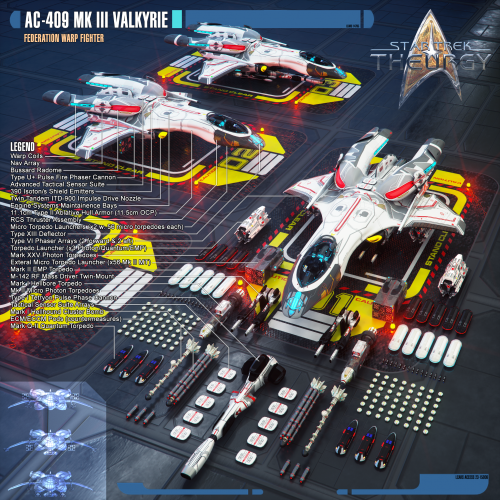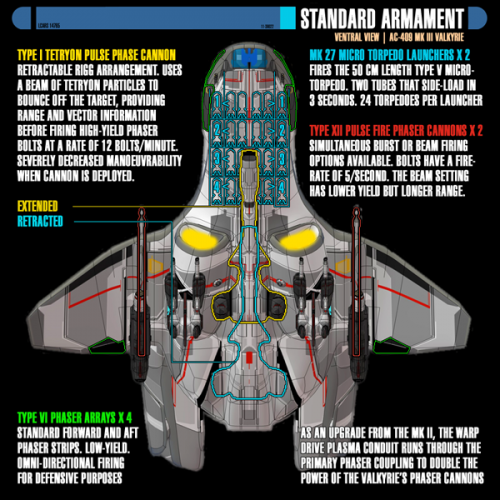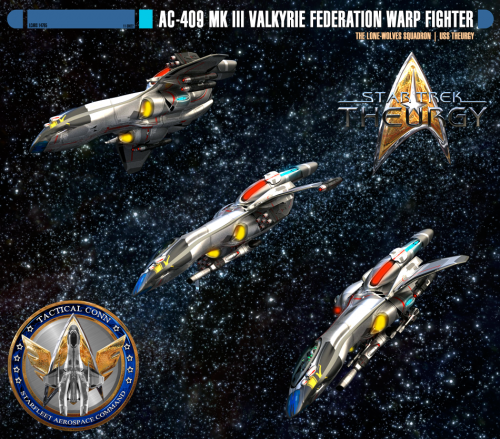AC-409 Mk III Valkyrie: Difference between revisions
From Star Trek: Theurgy Wiki
Auctor Lucan (talk | contribs) |
Auctor Lucan (talk | contribs) No edit summary |
||
| Line 1: | Line 1: | ||
[[File:Ac_409_mk_iii_valkyrie_federation_attack_fighter_by_auctor_lucan-d9fexjn.png|500px|right]] | |||
[UNDER CONSTRUCTION] | [UNDER CONSTRUCTION] | ||
These are the space fighters the Lone-Wolves Squadron use in Star Trek: Theurgy. | |||
=== AC-409 Mk III VALKYRIE SPECIFICATIONS === | === AC-409 Mk III VALKYRIE SPECIFICATIONS === | ||
==== Advantages ==== | ==== Advantages ==== | ||
* Wide variety of secondary weapons options | * Wide variety of secondary weapons options | ||
Revision as of 21:15, 1 June 2016
[UNDER CONSTRUCTION]
These are the space fighters the Lone-Wolves Squadron use in Star Trek: Theurgy.
AC-409 Mk III VALKYRIE SPECIFICATIONS
Advantages
- Wide variety of secondary weapons options
- Excellent hull armour and shielding
- Impressive sensors
- Can dish out as much of a pounding as it takes
Disadvantages
- Low maximum/standard warp speed
- Unwieldy tetryon pulse canon when extended
Specifications
- Length: 20,5 m Width: 13,9 m Height: 3,5 m Mass: 41,800 Kg
- (x1) Standard Pilot
- (x1) Micro Transporter Cluster
- (x1) Short-Range Tractor Beam Emitter
- Standard Environmental System
Tactical specs
- (x2) Type XII Pulse Fire Phaser Cannons (forward-facing)
- (x4) Type VI Phaser Arrays (2 forward & 2 aft)
- (x1) Type I Tetryon Pulse Phase Cannon (retracts underneath the hull)
- (x2) Mk 27 Micro Torpedo Launchers (24-round 50cm Microtorpedoes each)
Defensive specs
- 390 Isoton/s Shields
- Type XIII Deflector
- 11.1cm Type II Ablative Hull Armor (11.5cm OCP)
Engine specs
- Twin-tadem Quantite Reactor Core
- Wave Drive Propulsion System
- Twin Tandem ITD-900 Series Class V Impulse Drive
- Standard RCS Thruster Assembly
- Standard Speed: Warp 5.8
- Maximum Speed: Warp 7.6
- Maximum Cruise: 0.80 C
- Combat Speed: 970 Km/s
Command and control
- Type B Bio-Neural Geldisk FTL Core
- High Data Transfer Speed
- Nano Sub-processor Auxiliary Core
- (x1) Long Range Subspace Antennae
- (x2) Short Range Subspace Antennae
Sensors
- Advanced Tactical Sensor Suite
- High Resolution Sensor Range: 18,400,000 Km
- Low Resolution Sensor Range: 36,800,000 Km
- Standard Navigational Sensor Suite
- High Resolution Sensor Range: 5.2 Ly
- Low Resolution Sensor Range: 26.2 Ly
Other standard-issue equipment (stored in cockpit)
- Mk. III Phaser Assault Rifle
- Extra rations [14 days]
- Power cells [for the Exosuit's hand phaser as well as the rifle stored in the cockpit]
EXTERNAL HARD POINT OPTIONS (x4)
External hard points that are wing mounted. Before each battle, pick from the below list depending on availability.
ECM Pod/ECCM Emitter
Counter measures. ECM [Electric Counter Measure] is essentially is a micro torpedo full of shrapnel and debris with the given craft's transponder signature and sensor reading. It confuses the enemy ordinance and causes it to think the cloud of debris is the target. ECCM [Electric Chemical Counter Measure] creates a wake similar to a warp, impulse or thruster engine's wake, fooling such a guided missile into a false lock.
Additional Torpedo Launcher
Additional, wing-mounted torpedo launcher that can hold either 5 Mk XXVII photon torpedoes or 15 micro torpedoes. Recommended to mount two of these in order to balance the fighter properly.
Mk XXVII Photon Torpedo
Standard photon torpedo ordinance. Explosion is a matter-antimatter reaction producing large amounts of gamma waves as its primary means of destruction.
Mk Q-IV Quantum Torpedo
An improvement of the Mk XXVII photon torpedo with higher yield. A tactical quantum weapon, that utilize a plasma warhead and used casings similar in shape to photon torpedoes. The explosion leaves an antimatter residue and although they were powerful weapons, even a direct hit from a quantum torpedo might not destroy neutronium alloyed targets.
Mk I Hellborne Torpedo
Photon torpedo type weapon that results in a nuclear fission reaction, named for its use of standard nuclear radioactive bomb materials [Uranium, Plutonium etc.] The nuclear bomb detonates and this compresses hydrogen into helium creating a fusion reaction. Within the hydrogen core is a core of neutronium which the fusion reaction detonates. This detonation is equivalent 3 photon torpedo that detonate only a few moments after it contacts its target rather than detonating near the target, this because of the penetrate-and detonate-package in its casing. This weapon is highly ineffective against targets with fully powered shields. Against heavily armoured targets without any shielding left, this may be the only viable option that will punch through the heavy armour. The pilot can disable the penetrative package from the fighter to make one behave like a standard Tri-Nuclear Torpedo.
EMP Torpedo
Creates the electromagnetic pulse similar to what is created from the high atmosphere detonation of a nuclear warhead. A well shielded craft will withstand this easily but the weapon detonates in a burst of broadband, high-intensity electromagnetic energy, capable of disrupting magnetic fields and producing current or voltage surges in conductive materials via magnetic induction.
Hell Hound Cluster Bomb
Similar to the nature of a photon torpedo. Essentially, this is a photon torpedo stuffed with several micro torpedoes. The casing is opened upon a certain point releasing the small torps resulting in a large pattern of torpedo detonations.
EJECTION SYSTEMS
Escape Pod
All Valkyries are equipped with ejection modules or "pods". These allow for rapid emergency egress from the vehicle in case of danger. Linked to dedicated high speed processors, automatic sensors can detect certain types of danger and initiate an eject sequence automatically. This is especially useful if the pilot has been rendered unconscious through a blackout or other injury and the vehicle is in danger of crashing.
Modules have self-righting mechanisms in their base to assure a correct orientation during landing. Landing is accomplished by a single use anti-grav module. Free falling until they are 3 meters from the ground, the ejection seat/pod activates the AG module, which burns out as it lands the unit (relatively) gently. The pod remains pressurized with approximately 20 minutes of air, allowing a pilot time to completely seal his suit and activate his personal survival equipment. Once ready, the pilot has the option of discarding the pod by activating a manual release.
ETS [Emergency Transport System]
By the late 24th century, emergency transport was further improved through Starfleet's development of a single-person, single-use, one-way emergency transport unit. The device was small enough to be hand-held and could transport to specified coordinates with a single touch. Because of its extreme limitations, this device was not widely deployed and was still considered a prototype in 2379. [see Star Trek: Nemesis]
The Valkyries have built-in Emergency Transport Systems [ETS] in the cockpit - not the small prototype version - designated to the pilot and worn gear alone, with a one-way pre-set location for the USS Theurgy. The Emergency transporter can be reprogrammed to send the pilot to a new - by the pilot chosen - location because of the possibility of long-range missions, but this system is best utilised in the event of defending the Theurgy - being within Transporter range.



